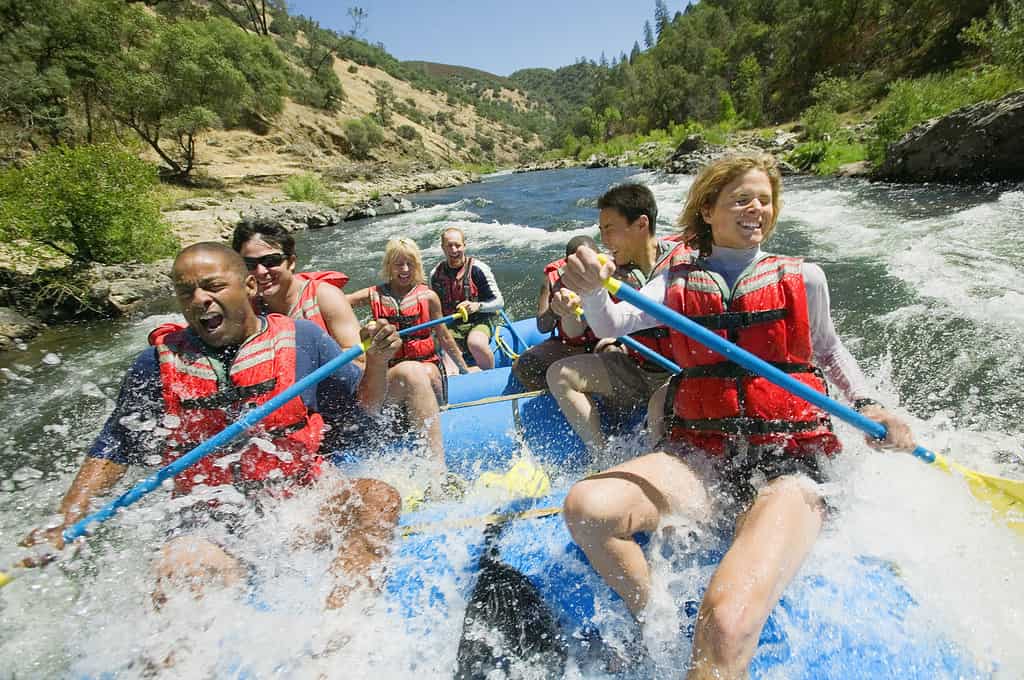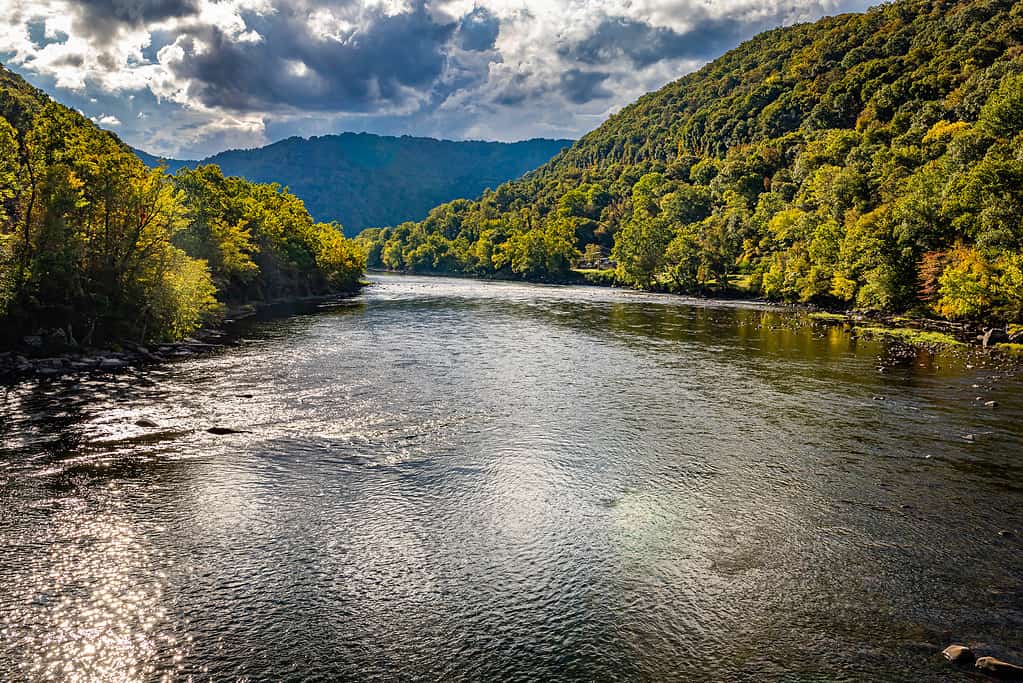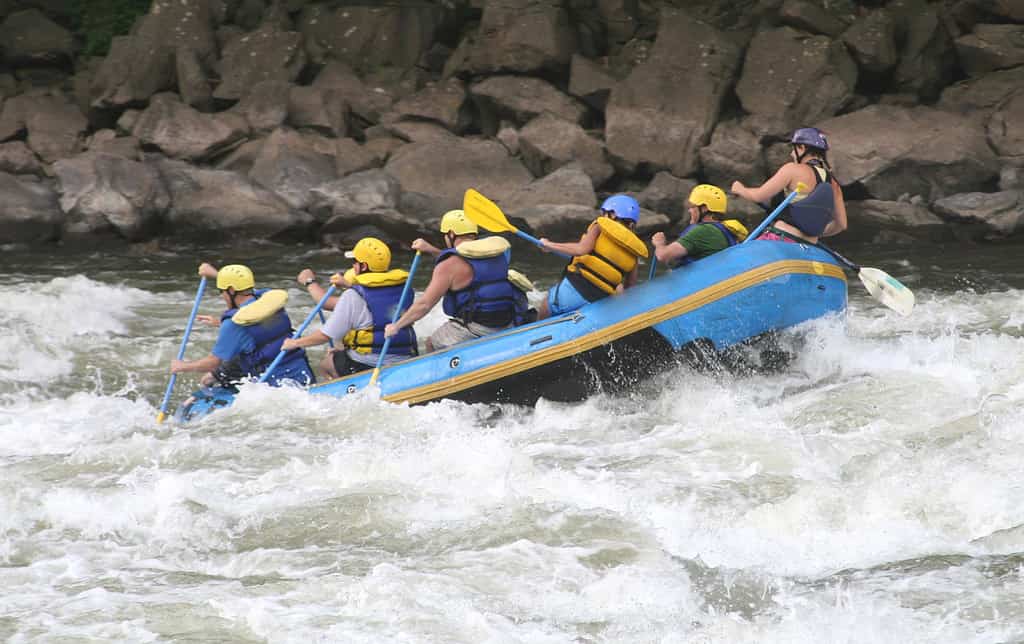
Whitewater rafting can be an activity for the whole family.
©Jupiterimages/Stockbyte via Getty Images
Wild and Wonderful West Virginia is home to gorgeous mountains, lush forests—and winding waterways that make the state a whitewater rafting hotspot. If you’re looking for the right amount of adventure and scenic beauty, be sure to visit one of the Mountain State’s rivers. Let’s explore the five best rivers for whitewater rafting in West Virginia.
Rapid Class Levels
You may notice that rivers are rated on a “class” scale. This information helps you determine the river difficulty and the required skill of the rafter. There are six levels, with Class I being the easiest and Class VI being the most difficult. These class levels take the water levels, plummets, and water speed into consideration. With this knowledge in mind, we can dive into the best rivers for whitewater rafting.
1. New River Gorge

The New River is one of the most popular places for whitewater rafting in West Virginia.
©Different_Brian/ via Getty Images
The New River Gorge National Park is one of the most popular spots for whitewater rafting. One of the oldest rivers in North America, this national park offers several water-based activities. The New River provides access to a variety of rapids, and there are water trips for both beginners and experts. Beginners might want to start with the Upper New River as this section of the river is milder. However, beginners are welcome to try out the Lower New River. If you’re a whitewater enthusiast, this stretch of water might just be for you! This stretch of water has large shelf drops and boulders, which enhances the waves.
Overall, the New River Gorge is great for families as well as those with varying levels of expertise. Although there are both beginner and advanced options, both parts of the New River are accessible to novices. No matter which part of the New River you choose, you’re bound to have an unforgettable experience!
Class Level: Class I-III
2. Gauley River

The New River and Gauley River connect near the Gauley Bridge.
©Malachi Jacobs/Shutterstock.com
The Gauley River is considered to be one of the best whitewater rivers in the United States. The Gauley River has more than 100 rapids with steep drops and huge waves. Nearly 60,000 people visit the Gauley River each year for a harrowing adventure through the rapids. Similar to the New River, the Gauley River is divided into Upper and Lower.
The Upper Gauley is for experts, and it consists of the “Big 5”: Insignificant, Pillow Rock, Lost Paddle, Iron Ring, and Sweet’s Falls. These rapids are filled with massive drops, intense waves, and unexpected plunges, requiring a minimum age of 16. However, the Lower Gauley River, while still intended for more advanced individuals, is far less intense. The minimum age for the Lower Gauley River is 12-14 years old. Although the Gauley River isn’t necessarily friendly for all ages or experience levels, for thrill seekers, this is a great place to test your bravery and willpower.
Class Level: The Lower Gauley has Class II-IV while the Upper Gauley is solely Class V.
3. Shenandoah River

Whitewater rafting on the New River in West Virginia has options for novice and expert rafters.
©Andrea Pelletier/iStock via Getty Images
Perfect for families and beginners, the Shenandoah River provides a relaxed and enjoyable whitewater experience. The gentle waves make this stretch of the Shenandoah River Valley perfect for a lowkey water activity. The waterway spans nearly 6.5 miles before it connects with the Potomac River, and the watercourse provides lovely views of the Blue Ridge Mountains. If you’re looking for a tame whitewater rafting experience with stunning views, the Shenandoah River is just for you!
Class Level: Class I-III
4. Cheat River

Rapids that fall into Classes I-III are considered safe for whitewater kayaking.
©© Robert Pernell/iStock via Getty Images
The Cheat River, located in North Central West Virginia, is less known to whitewater enthusiasts, but it offers beginner and advanced rafting experiences. The Cheat Canyon is intended for more advanced rafters as the area is noted as Class IV. This 13-mile section is filled with adventure—all sorts of drops and plummets. The Cheat Narrows, the more scenic and calmer side, is a more beginner-friendly option. No matter your experience level, whitewater rafting on the Cheat River provides beautiful views of the Allegheny Mountains.
Class Level: Class IV, Class II-III
5. Tygart River

Whitewater rafting can be an intense and thrilling activity depending on the river’s class.
©Digital Vision./Photodisc via Getty Images
The Tygart River is another lesser-known river in West Virginia, but it provides whitewater rafting options for various skill levels. With 4.7 miles of waterfalls and rapids, the Tygart River is more off the beaten path, which means there is much more solitude and scenic views.
Class Level: Class III-V
What Rivers Should I Avoid?
While the locations on this list offer beginner and advanced options, some rivers are not recommended for whitewater rafting. Some waterways are not ideal for water activity based on speed, drops, or structure. For instance, the Cranberry River and Williams River have narrow channels that are not ideal for rafting.
Whitewater Rafting in West Virginia
West Virginia is home to so many different natural wonders, and enjoying the state’s rivers is an experience like no other. Whether you’re looking for family-friendly, beginner, or experienced, the rivers on this list will give you the adventure you crave. Be sure to check out these whitewater rafting locations in West Virginia!
Summary of the Discover the 5 Best Rivers for Whitewater Rafting in West Virginia
| Rank | River | Location | Class Level |
|---|---|---|---|
| 1 | New River | Fayetteville, WV | Class I-III |
| 2 | Gauley River | Lansing, WV | Class II-V |
| 3 | Shenandoah River | Harpers Ferry, WV | Class I-III |
| 4 | Cheat River | Albright, WV | Class II-IV |
| 5 | Tygart River | Belington, WV | Class III-V |
The photo featured at the top of this post is © joshschutz/iStock via Getty Images
Thank you for reading! Have some feedback for us? Contact the AZ Animals editorial team.






